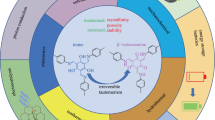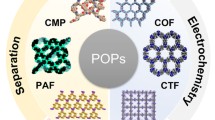Abstract
A series of p-alkoxylbenzamides featuring a long alkyl chain have been synthesized and are readily to form stable gels in a variety of organic solvents. Their self-assembly properties and structure-property relationship were investigated by scanning electron microscopy, X-ray diffraction, 1H nuclear magnetic resonance, and Fourier transform infrared spectroscopy. The gels formed were multi-responsive to environmental stimuli such as temperature and fluoride anion. The results show that a combination of hydrogen bonding, π-π stacking and van der Waals interaction result in the aggregation of p-alkoxylbenzamides to form three-dimension networks, depending on the length of the long alkyl chain.

Similar content being viewed by others
References
Aldred M P, Eastwood A J, Kelly S M, Vlachos P, Contoret A E A, Farrar S R, Mansoor B, O’Neill M, Tsoi W C. Light-emitting fluorene photoreactive liquid crystals for organic electroluminescence. Chemistry of Materials, 2004, 16(24): 4928–4936
Hafkamp R J, Kokke P A, Danke I M, Guerts H P M, Rowan A E, Feiters M C, Nolte R J M. Organogel formation and molecular imprinting by functionalized gluconamides and their metal complexes. Chemical Communications, 1997, 6(6): 545–546
Dai H, Chen Q, Qin H, Guan Y, Shen D, Hua Y, Tang Y, Xu J. A temperature responsive copolymer hydrogel in controlled drug delivery. Macromolecules, 2006, 39(19): 6584–6589
Kuroiwa K, Shibata T, Takada A, Nemoto N, Kimizuka N. Heat-set gel-like networks of lipophilic Co(II) triazole complexes in organic media and their thermochromic structural transitions. Journal of the American Chemical Society, 2004, 126(7): 2016–2021
Mizrahi S, Gun J, Kipervaser Z G, Lev O A. Electrophoresis in organogels. Chemical Communications, 2004, 76: 5399–5404
Terech P, Weiss R G. Low molecular mass gelators of organic liquids and the properties of their gels. Chemical Reviews, 1997, 97(8): 3133–3160
Van Esch J H, Feringa B L. New functional materials based on self-assembling organogels: from serendipity towards design. Angewandte Chemie International Edition, 2000, 39(13): 2263–2266
Gronwald O, Shinkai S. Sugar-integrated gelators of organic solvents. Chemistry (Weinheim an der Bergstrasse, Germany), 2001, 7(20): 4328–4334
Fages F, Vogtle F, Zinic M. Systematic design of amide and urea type gelators with tilored properties. Topics in Current Chemistry, 2006, 37(33): 77–78
Abdallah D J, Weiss R G. n-Alkanes gel n-alkanes (and many other organic liquids). Langmuir, 2000, 16(2): 352–355
Chow H F, Zhang J, Lo C M, Cheung S Y, Wong K W. Improving the gelation properties of 3,5-diaminobenzoate-basedorganogelators in Aromatic solvents with additional aromatic-containing Pendants. Tetrahedron, 2007, 63(2): 363–365
Murata K, Aoki M, Nishi T, Ikeda A, Shinkai S. New cholesterolbased gelators with light-and metal-responsive functions. Chemical Communications, 1991, 24(24): 1715–1718
Naota T, Koori H J. Molecules that assemble by sound: an application to the instant gelation of stable organic fluids. Journal of the American Chemical Society, 2005, 127(26): 9324–9325
Kawano S I, Fujita N, Shinkai S. A coordination gelator that shows a reversible chromatic change and sol-gel phase-transition behavior upon oxidative/reductive stimuli. Journal of the American Chemical Society, 2004, 126(28): 8592–8593
Wang C, Robertson A, Weiss R G. “Latent” trialkylphosphine and trialkylphosphine oxide organogelators activated by Brønsted and Lewis Acids. Langmuir, 2003, 19(4): 1036–1046
Aggeli A, Bell M, Boden N, Keen J N, Knowles P F, McLeish T C B, Pitkeathly M, Radford S E. Responsive gels formed by the spontaneous self-assembly of peptides into polymeric beta-sheet tapes. Nature, 1997, 386(622): 259–262
Liu J W, Yang Y, Chen C F, Ma J T. Novel anion-tuning supramolecular gels with dual-channel response: Reversible solgel transition and color changes. Langmuir, 2010, 26(11): 9040–9044
Luo X Z, Liu B, Liang Y Q. Self-assembled organogels formed by mono-chain-alanine derivatives. Chemical Communications, 2001, 17(17): 1556–1557
Luo X Z, Li C, Liang Y Q. Self-assembled organogels formed by monoalkyl derivatives of oxamide. Chemical Communications, 2000, 17(21): 2091–2092
Huang Y D, Tu W, Yuan Y Q, Fan D L. Novel organogelators based on pyrazine-2, 5-dicarboxylic acid derivatives and their mesomorphic behaviors. Tetrahedron, 2014, 70(6): 127–1282
Huang Y D, Dong X L, Zhang L L, Chai W, Chang J Y. Structureproperty correlation of benzoyl thiourea derivatives as organogelators. Journal of Molecular Structure, 2013, 1031: 43–48
Maeda H. Anion-responsive supramolecular gels. Chemistry (Weinheim an der Bergstrasse, Germany), 2008, 14(36): 11274–11282
Cametti M, Rissanen K. Highlights on contemporary recognition and sensing of fluoride anion in solution and in the solid state. Chemical Society Reviews, 2013, 42(5): 2016–2038
Zhang Y M, Lin Q, Wei T B, Qin X P, Li Y. A novel smart organogel which could allow a two channel anion response by proton controlled reversible sol-gel transition and color changes. Chemical Communications (Cambridge), 2009 (40): 6074–6076
Author information
Authors and Affiliations
Corresponding author
Rights and permissions
About this article
Cite this article
Zhai, Y., Chai, W., Cao, W. et al. Organogelators based on p-alkoxylbenzamide and their self-assembling properties. Front. Chem. Sci. Eng. 9, 488–493 (2015). https://doi.org/10.1007/s11705-015-1503-9
Received:
Accepted:
Published:
Issue Date:
DOI: https://doi.org/10.1007/s11705-015-1503-9




